Pugettia producta (Randall, 1839)Common name(s): Shield-backed kelp crab, Northern kelp crab, Kelp crab |
|
| Synonyms: Epialtus productus, Pugettia productus | 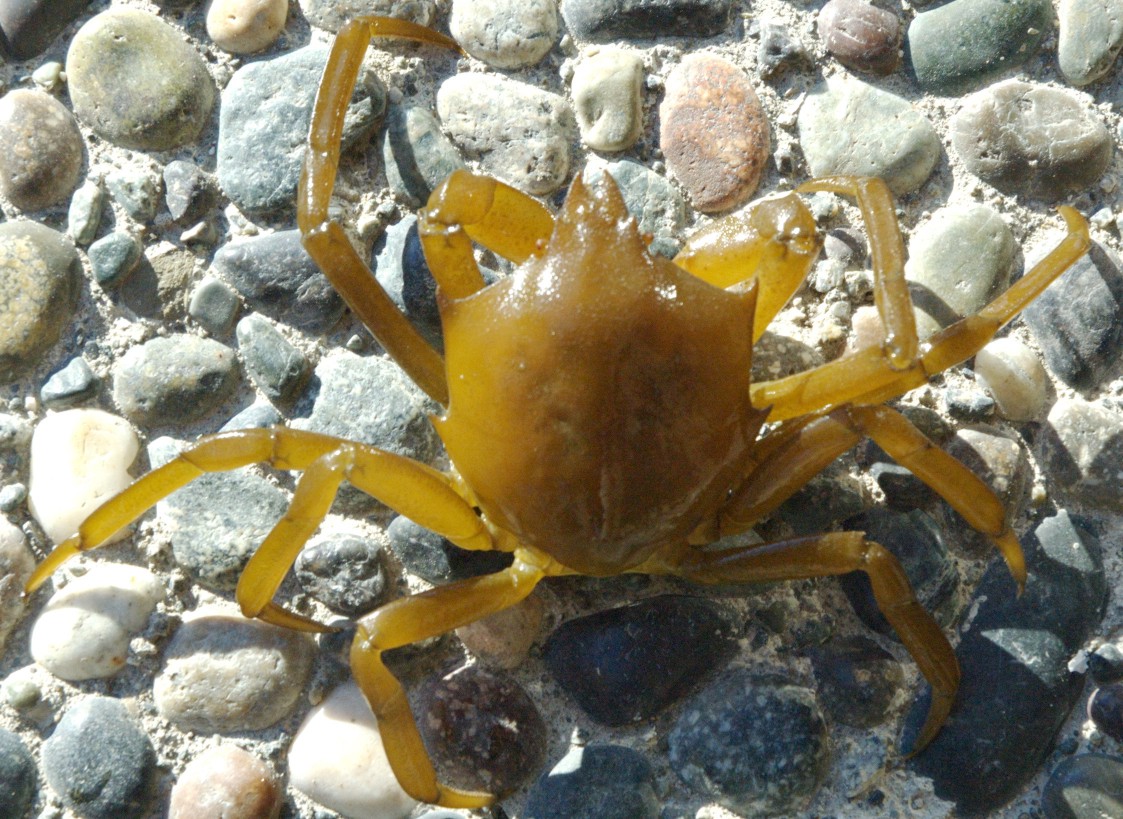 |
| Phylum Arthropoda
Subphylum Crustacea Class Malacostraca Subclass Eumalacostraca Superorder Eucarida Order Decapoda Suborder Pleocyemata Infraorder Brachyura (true crabs) Family Majidae (Now in Family Epialtidae) |
|
| Pugettia producta from Sharpe Cove dock (running from me). Carapace length 6 cm. | |
| (Photo by: Dave Cowles July 2011) | |
How to Distinguish from Similar Species: Pugettia gracilis does not grow as large, and its dorsal carapace is rough. Scyra acutifrons has a rounder, rougher carapace. The carapace of Hyas lyratus is wider in front, and is also rougher. Cancer productus is a cancer crab (and has a round carapace and no rostrum)
Geographical Range: Chichagof Island, Alaska to Ascuncion Point, Mexico
Depth Range: Intertidal to 73 m
Habitat: Mostly in kelp beds, either on the bottom or climbing in the kelp (photo). Also common on pilings. Juveniles may be in tidepools or around surfgrass or Fucus.
Biology/Natural
History: This species
does not decorate itself as much as some other majid crabs
do. It
does have two rows of hooked setae just behind its rostrum, to which it
sometimes attaches algae, etc. The items it attaches may be
mainly
food, which it detaches and eats later. This crab eats algae
such
as Fucus, Macrocystis, Nereocystis,
Sargassum,
Egregia,
Pterygophora,
and red algae. Where algae is scarce they may eat barnacles,
mussels,
hydroids, and bryozoans. Predators include staghorn sculpins,
gulls,
cabezon, and sea otter. Velella
velella, the by-the-wind sailor, will readily
capture and eat the
pelagic larvae (zoeae). The species is sometimes parasitized
by the
rhizocephalan sacculinid barnacle Heterosaccus californicus,
which
causes the crabs to be sluggish and to have a brownish mass (the
reproductive
parts of the barnacle) protruding from under the abdomen. The crab
molts
only once after being parasitized, and during that molt the barnacle's
reproductive sac pushes out through the surface. The crab's
gonads
are damaged or destroyed and males exhibit some female-like
characteristics
such as a broad abdomen and small claws. He may even become a
hermaphrodite
and produce eggs as well as sperm. Females seem less affected
other
than speeding up the development of mature female
characteristics.
This species cannot osmoregulate so it cannot tolerate diluted
seawater.
The species has a terminal molt, after which the carapace may become
partly
overgrown with barnacles, etc. In the fall adults migrate to
deeper
water where they congregate, feed, and mate. Females may be
carrying
eggs during most seasons of the year. In southern Puget Sound
females
could not be found during May, September, and October. Clutch
size
ranges from 34,000 to 84,000 eggs. Freshly extruded eggs are
bright
orange, maturing to red, and to grayish-purple at hatching.
Embryonic
development may require nearly a year. Note: The
long legs
and claws of these crabs are dextrous and they can cling tenaciously
and
pinch hard, so be warned.
| Return to: | |||
| Main Page | Alphabetic Index | Systematic Index | Glossary |
References:
Dichotomous Keys:Coffin, 1952
Flora and Fairbanks, 1966
Hart, 1982
Kozloff 1987, 1996
Smith and Carlton, 1975
Wicksten, 2009
General References:
Brandon
and Rokop, 1985
Brusca
and Brusca, 1978
Gotshall,
1994
Harbo,
1999
Hinton,
1987
Jensen,
1995
Johnson
and Snook, 1955 (as Epialtus productus)
Kozloff,
1993
McConnaughey
and McConnaughey, 1985
Morris
et al., 1980
Niesen,
1994
Niesen,
1997
O'Clair
and O'Clair, 1998
Ricketts
et al., 1985
Sept,
1998
Scientific Articles:
Hultgren, Kristin M. and John J. Stachowicz, 2008.
Alternative
camouflaage strategies mediate predation risk among closely related
co-occurring
kelp crabs. Oecologia 155: 519-528
Web sites:
General Notes and Observations: Locations, abundances, unusual behaviors:
While this crab is common among kelp in some places along the coast, it is not very common (though present) near Rosario.
A view of the underside.
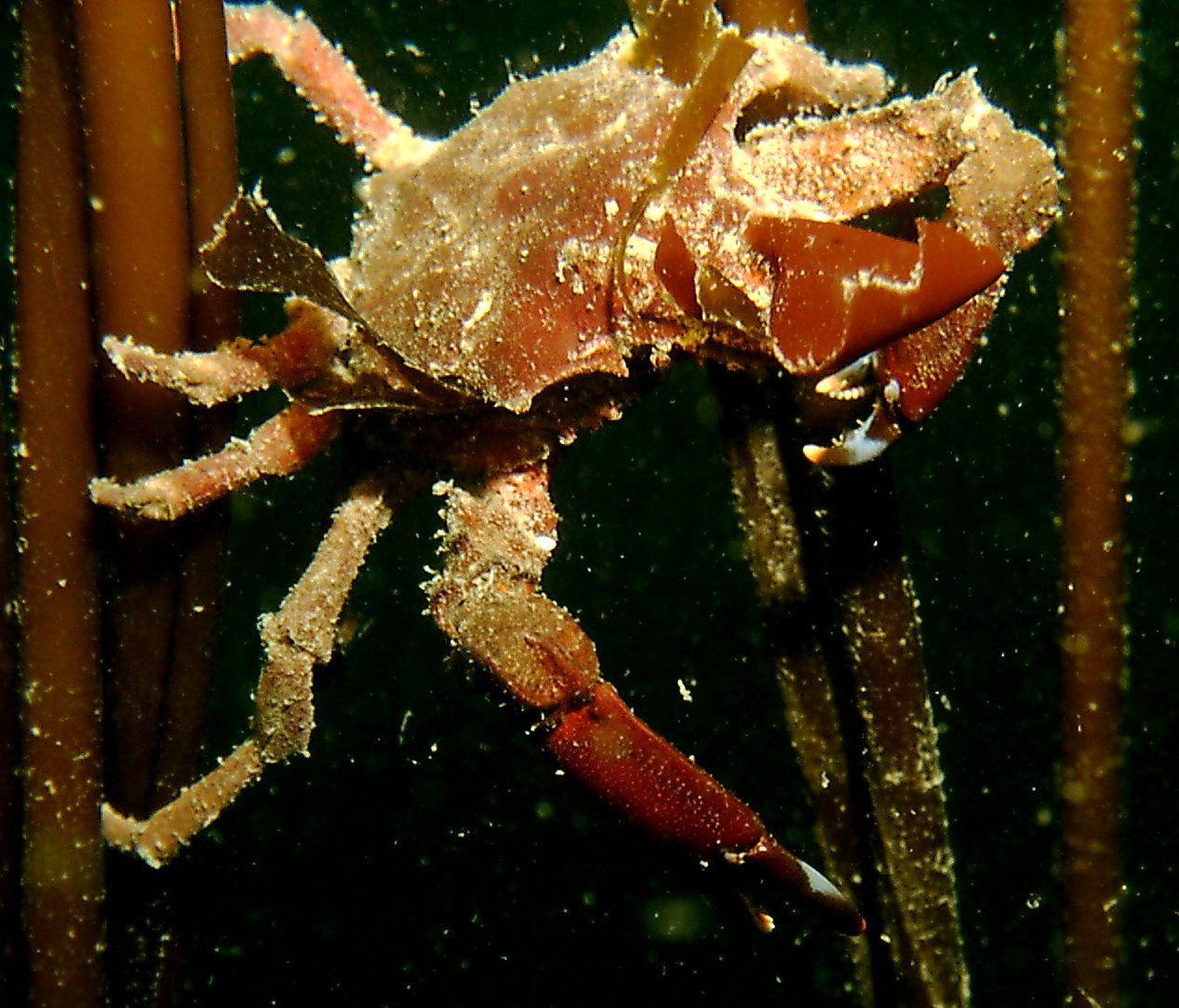
This individual, photographed underwater, is clinging to the stalks
of Nereocystis kelp. Photo July 2005 by
Jim Nestler
| View from above and below of another individual. This male was found clinging to the dock in Sharpe's Cove. Photos by Dave Cowles, August 2012 | |
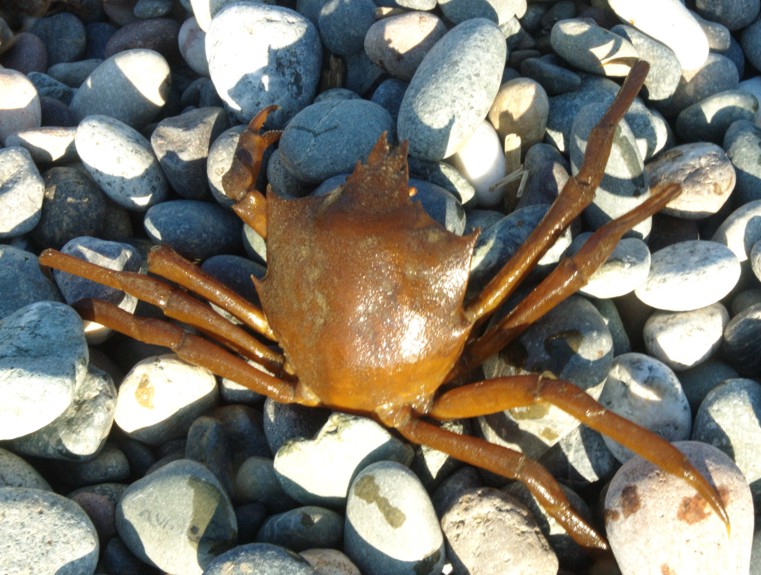 |
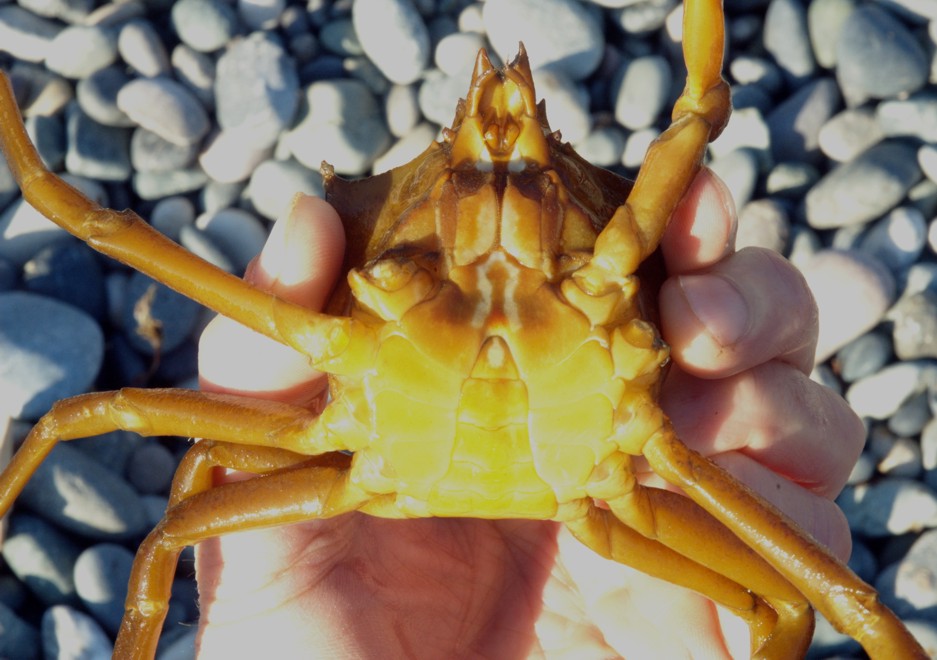 |
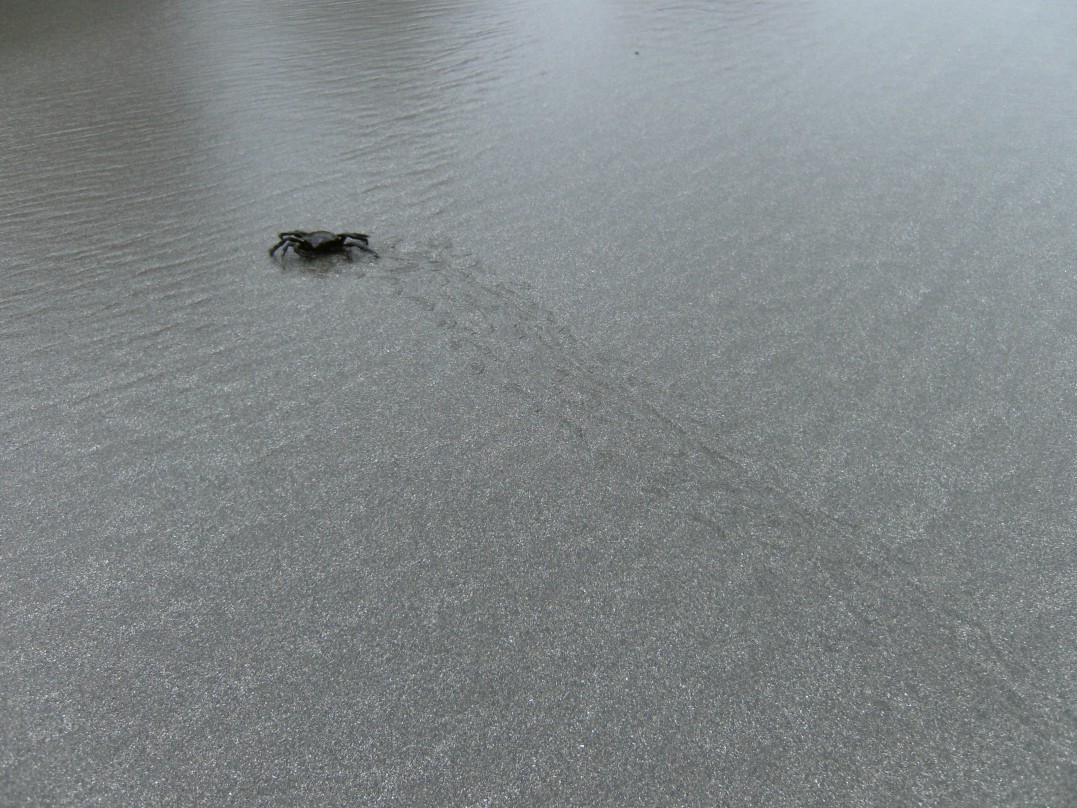
This individual is running across a tidal flat at Shi Shi beach at
low tide, leavng a crab trail behind. Note that, like all
crabs,
it runs sideways.
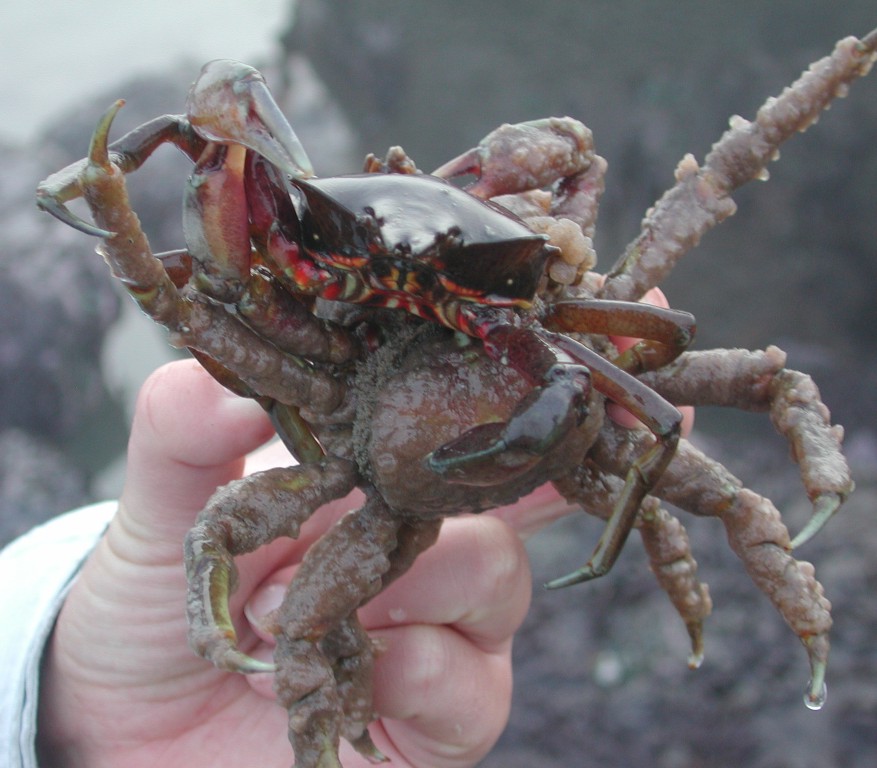
This pair was found at Beach #4 at Kalaloch. The
smooth male (facing
the camera) is clinging tenaciously to a larger female, who is
encrusted
with colonial tunicates. Male crabs often hold and protect a
female
until she molts, then breed with her while her gonopores are
soft.
The abundant tunicate growth on this female suggests that she has not
molted
for a long time, so she may be due for a molt soon. Note that
the
underside of this male is more red than the underside shown
above.
Photo by Dave Cowles, July 2009.
Authors and Editors of Page:
Dave Cowles (2005): Created original page
